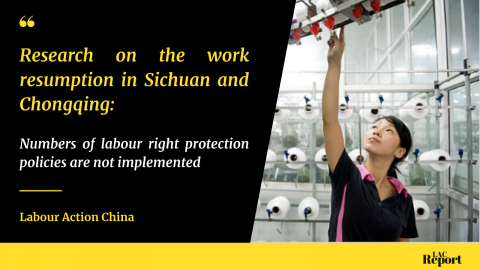
|
Type |
Option |
Ratio |
|
Gender (109 valid responses) |
Female |
44.83% |
|
Male |
55.17% |
|
|
Age |
16-25 |
7.94% |
|
26-35 |
22.22% |
|
|
36-45 |
23.03% |
|
|
46-55 |
30.95% |
|
|
56 or above |
15.87% |
|
|
Household register |
Sichuan |
64.29% |
|
Chongqing |
35.71% |
|
|
Place of work |
Guangdong |
33.33% |
|
Sichuan |
48.41% |
|
|
Chongqing |
18.25% |
|
|
Industry |
Metal hardware |
9.52% |
|
Furniture |
15.03% |
|
|
Household electrical appliance |
10.32% |
|
|
Plastic |
12.70% |
|
|
Construction |
26.98% |
|
|
Others |
25.40% |
|
|
Job position |
Workers |
60.32% |
|
Management |
8.73% |
|
|
Clerical |
6.35% |
|
|
Others |
24.60% |
|
|
Number of employees in the workplace |
Less than 10 |
10.32% |
|
10-50 |
25.40% |
|
|
50-200 |
32.54% |
|
|
200-1000 |
18.25% |
|
|
Over 1000 |
13.49% |
|
Option |
Number |
Ratio |
|
|
Delayed |
104 |
82.54% |
|
|
Not delayed |
All employees |
8 |
6.35% |
|
Partially |
14 |
11.11% |
|
|
Option |
Number |
Ratio |
|
February |
12 |
11.01% |
|
March |
31 |
28.44% |
|
April |
46 |
42.20% |
|
May |
20 |
18.35% |
|
109 valid responses for this question |
||
|
Option |
Number |
Ratio |
|
Normal payment |
34 |
39.08% |
|
Delayed payment |
12 |
13.79% |
|
Partial payment |
8 |
9.20% |
|
No payment |
31 |
35.63% |
|
Others |
2 |
2.30% |
|
Option |
Number |
Ratio |
|
Work in companies |
76 |
69.72% |
|
Work from home |
10 |
9.17% |
|
Others |
23 |
21.10% |
|
Valid responses: 109 |
||
|
Option |
Number |
Ratio |
|
No payment |
4 |
19.05% |
|
Partial payment |
8 |
38.10% |
|
Normal payment |
9 |
42.86% |
|
Option |
Number |
Ratio |
|
No change |
37 |
33.94% |
|
Increased |
8 |
7.34% |
|
Decreased |
64 |
58.72% |
|
109 valid responses to this question |
||
|
Option |
Number |
Ratio |
|
Layoffs |
35 |
41.18% |
|
Alternative work |
31 |
36.47% |
|
Partially delayed resumption |
15 |
17.65% |
|
Others |
4 |
4.71% |
|
Option |
Number |
Ratio |
|
Economic redundancy |
65 |
83.33% |
|
End of contract |
3 |
3.85% |
|
Bankruptcy |
8 |
10.26% |
|
Quarantine |
0 |
0.00% |
|
Others |
2 |
2.56% |
